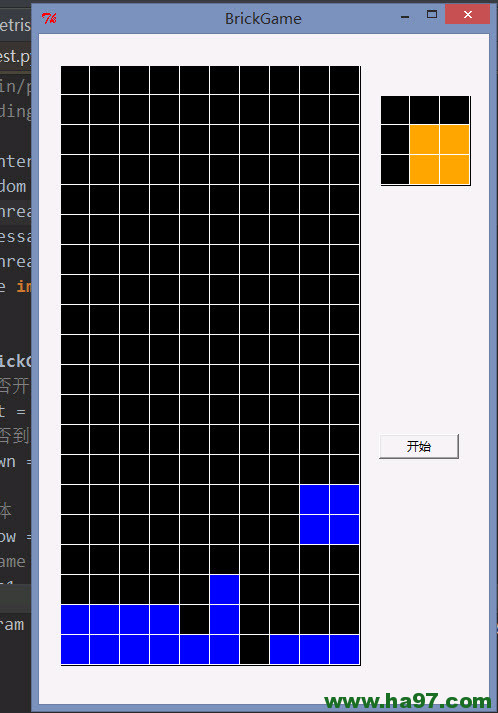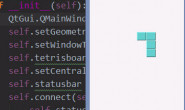PS:最近学习用Python怎么写小游戏,研究了几个俄罗斯方块的代码。记录一下:
第一个实现代码如下,这个使用了内置的模块实现的,在PY2.7版本直接运行,在3.x版本需要修改部分语法:
#!/usr/bin/python
# -*- coding: utf-8 -*-
from Tkinter import *;
from random import *;
import thread;
from tkMessageBox import showinfo;
import threading;
from time import sleep;
class BrickGame(object):
# 是否开始
start = True;
# 是否到达底部
isDown = True;
# 窗体
window = None;
# frame
frame1 = None;
frame2 = None;
# 按钮
btnStart = None;
# 绘图类
canvas = None;
canvas1 = None;
# 标题
title = "BrickGame";
# 宽和高
width = 450;
height = 670;
# 行和列
rows = 20;
cols = 10;
# 下降方块的线程
downThread = None;
# 几种方块
brick = [
[
[
[1, 1, 1],
[0, 0, 1],
[0, 0, 0]
],
[
[0, 0, 1],
[0, 0, 1],
[0, 1, 1]
],
[
[0, 0, 0],
[1, 0, 0],
[1, 1, 1]
],
[
[1, 1, 0],
[1, 0, 0],
[1, 0, 0]
]
],
[
[
[0, 0, 0],
[0, 1, 1],
[0, 1, 1]
],
[
[0, 0, 0],
[0, 1, 1],
[0, 1, 1]
],
[
[0, 0, 0],
[0, 1, 1],
[0, 1, 1]
],
[
[0, 0, 0],
[0, 1, 1],
[0, 1, 1]
]
],
[
[
[1, 1, 1],
[0, 1, 0],
[0, 1, 0]
],
[
[0, 0, 1],
[1, 1, 1],
[0, 0, 1]
],
[
[0, 1, 0],
[0, 1, 0],
[1, 1, 1]
],
[
[1, 0, 0],
[1, 1, 1],
[1, 0, 0]
]
],
[
[
[0, 1, 0],
[0, 1, 0],
[0, 1, 0]
],
[
[0, 0, 0],
[1, 1, 1],
[0, 0, 0]
],
[
[0, 1, 0],
[0, 1, 0],
[0, 1, 0]
],
[
[0, 0, 0],
[1, 1, 1],
[0, 0, 0]
]
]
];
# 当前的方块
curBrick = None;
# 当前方块数组
arr = None;
arr1 = None;
# 当前方块形状
shape = -1;
# 当前方块的行和列(最左上角)
curRow = -10;
curCol = -10;
# 背景
back = list();
# 格子
gridBack = list();
preBack = list();
# 初始化
def init(self):
for i in range(0, self.rows):
self.back.insert(i, list());
self.gridBack.insert(i, list());
for i in range(0, self.rows):
for j in range(0, self.cols):
self.back[i].insert(j, 0);
self.gridBack[i].insert(j, self.canvas.create_rectangle(30 * j, 30 * i, 30 * (j + 1), 30 * (i + 1),
fill="black"));
for i in range(0, 3):
self.preBack.insert(i, list());
for i in range(0, 3):
for j in range(0, 3):
self.preBack[i].insert(j, self.canvas1.create_rectangle(30 * j, 30 * i, 30 * (j + 1), 30 * (i + 1),
fill="black"));
# 绘制游戏的格子
def drawRect(self):
for i in range(0, self.rows):
for j in range(0, self.cols):
if self.back[i][j] == 1:
self.canvas.itemconfig(self.gridBack[i][j], fill="blue", outline="white");
elif self.back[i][j] == 0:
self.canvas.itemconfig(self.gridBack[i][j], fill="black", outline="white");
# 绘制预览方块
for i in range(0, len(self.arr1)):
for j in range(0, len(self.arr1[i])):
if self.arr1[i][j] == 0:
self.canvas1.itemconfig(self.preBack[i][j], fill="black", outline="white");
elif self.arr1[i][j] == 1:
self.canvas1.itemconfig(self.preBack[i][j], fill="orange", outline="white");
# 绘制当前正在运动的方块
if self.curRow != -10 and self.curCol != -10:
for i in range(0, len(self.arr)):
for j in range(0, len(self.arr[i])):
if self.arr[i][j] == 1:
self.canvas.itemconfig(self.gridBack[self.curRow + i][self.curCol + j], fill="blue",
outline="white");
# 判断方块是否已经运动到达底部
if self.isDown:
for i in range(0, 3):
for j in range(0, 3):
if self.arr[i][j] != 0:
self.back[self.curRow + i][self.curCol + j] = self.arr[i][j];
# 判断整行消除
self.removeRow();
# 判断是否死了
self.isDead();
# 获得下一个方块
self.getCurBrick();
# 判断是否有整行需要消除
def removeRow(self):
for i in range(0, self.rows):
tag1 = True;
for j in range(0, self.cols):
if self.back[i][j] == 0:
tag1 = False;
break;
if tag1 == True:
# 从上向下挪动
for m in xrange(i - 1, 0, -1):
for n in range(0, self.cols):
self.back[m + 1][n] = self.back[m][n];
# 获得当前的方块
def getCurBrick(self):
self.curBrick = randint(0, len(self.brick) - 1);
self.shape = 0;
# 当前方块数组
self.arr = self.brick[self.curBrick][self.shape];
self.arr1 = self.arr;
self.curRow = 0;
self.curCol = 1;
# 是否到底部为False
self.isDown = False;
# 监听键盘输入
def onKeyboardEvent(self, event):
# 未开始,不必监听键盘输入
if self.start == False:
return;
# 记录原来的值
tempCurCol = self.curCol;
tempCurRow = self.curRow;
tempShape = self.shape;
tempArr = self.arr;
direction = -1;
if event.keycode == 37:
# 左移
self.curCol -= 1;
direction = 1;
elif event.keycode == 38:
# 变化方块的形状
self.shape += 1;
direction = 2;
if self.shape >= 4:
self.shape = 0;
self.arr = self.brick[self.curBrick][self.shape];
elif event.keycode == 39:
direction = 3;
# 右移
self.curCol += 1;
elif event.keycode == 40:
direction = 4;
# 下移
self.curRow += 1;
if self.isEdge(direction) == False:
self.curCol = tempCurCol;
self.curRow = tempCurRow;
self.shape = tempShape;
self.arr = tempArr;
self.drawRect();
return True;
# 判断当前方块是否到达边界
def isEdge(self, direction):
tag = True;
# 向左,判断边界
if direction == 1:
for i in range(0, 3):
for j in range(0, 3):
if self.arr[j][i] != 0 and (
self.curCol + i < 0 or self.back[self.curRow + j][self.curCol + i] != 0):
tag = False;
break;
# 向右,判断边界
elif direction == 3:
for i in range(0, 3):
for j in range(0, 3):
if self.arr[j][i] != 0 and (
self.curCol + i >= self.cols or self.back[self.curRow + j][self.curCol + i] != 0):
tag = False;
break;
# 向下,判断底部
elif direction == 4:
for i in range(0, 3):
for j in range(0, 3):
if self.arr[i][j] != 0 and (
self.curRow + i >= self.rows or self.back[self.curRow + i][self.curCol + j] != 0):
tag = False;
self.isDown = True;
break;
# 进行变形,判断边界
elif direction == 2:
if self.curCol < 0:
self.curCol = 0;
if self.curCol + 2 >= self.cols:
self.curCol = self.cols - 3;
if self.curRow + 2 >= self.rows:
self.curRow = self.curRow - 3;
return tag;
# 方块向下移动
def brickDown(self):
while True:
if self.start == False:
print("exit thread");
break;
tempRow = self.curRow;
self.curRow += 1;
if self.isEdge(4) == False:
self.curRow = tempRow;
self.drawRect();
# 每一秒下降一格
sleep(1);
# 点击开始
def clickStart(self):
self.start = True;
for i in range(0, self.rows):
for j in range(0, self.cols):
self.back[i][j] = 0;
self.canvas.itemconfig(self.gridBack[i][j], fill="black", outline="white");
for i in range(0, len(self.arr)):
for j in range(0, len(self.arr[i])):
self.canvas1.itemconfig(self.preBack[i][j], fill="black", outline="white");
self.getCurBrick();
self.drawRect();
self.downThread = threading.Thread(target=self.brickDown, args=());
self.downThread.start();
# 判断是否死了
def isDead(self):
for j in range(0, len(self.back[0])):
if self.back[0][j] != 0:
showinfo("提示", "你挂了,再来一盘吧!");
self.start = False;
break;
# 运行
def __init__(self):
self.window = Tk();
self.window.title(self.title);
self.window.minsize(self.width, self.height);
self.window.maxsize(self.width, self.height);
self.frame1 = Frame(self.window, width=300, height=600, bg="black");
self.frame1.place(x=20, y=30);
self.frame2 = Frame(self.window, width=90, height=90, bg="black");
self.frame2.place(x=340, y=60);
self.canvas = Canvas(self.frame1, width=300, height=600, bg="black");
self.canvas1 = Canvas(self.frame2, width=90, height=90, bg="black");
self.btnStart = Button(self.window, text="开始", command=self.clickStart);
self.btnStart.place(x=340, y=400, width=80, height=25);
self.init();
# 获得当前的方块
self.getCurBrick();
# 按照数组,绘制格子
self.drawRect();
self.canvas.pack();
self.canvas1.pack();
# 监听键盘事件
self.window.bind("<KeyPress>", self.onKeyboardEvent);
# 启动方块下落线程
self.downThread = threading.Thread(target=self.brickDown, args=());
self.downThread.start();
self.window.mainloop();
self.start = False;
pass;
if __name__ == '__main__':
brickGame = BrickGame();
注意:这个程序依赖图形界面,要在图形界面上才能正常运行,win和Linux的图形界面都可以。在纯终端命令界面是不能正常运行的。





